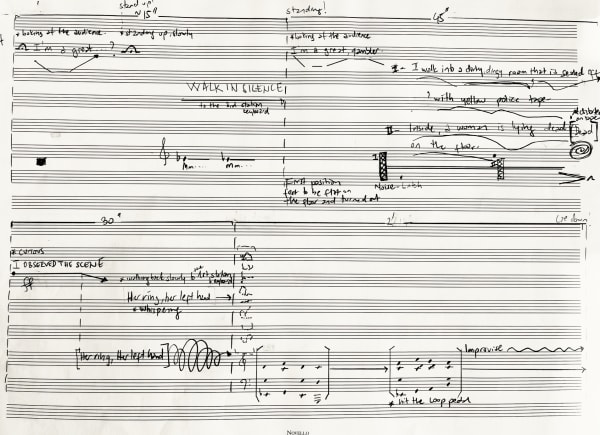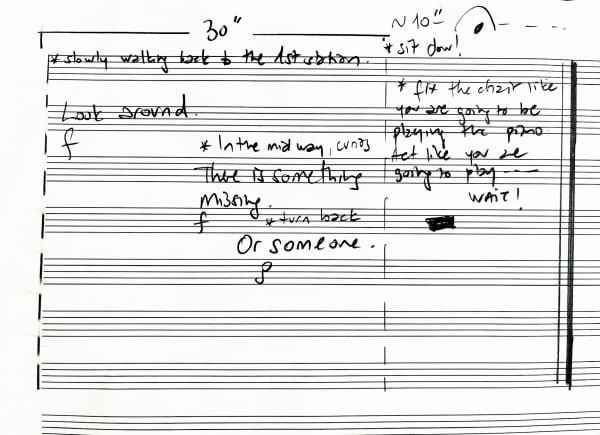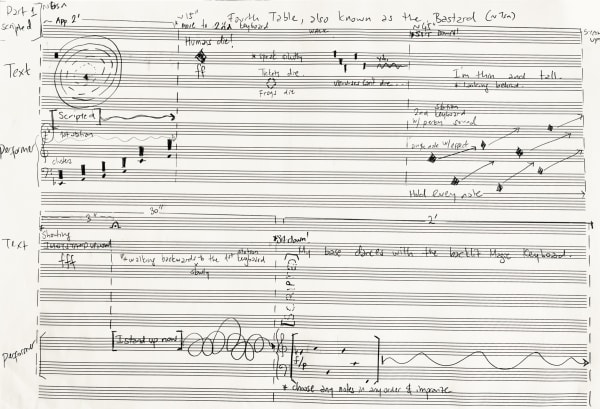Scripted Expanded Molded I : İrem Günaydın
Past exhibition
Press release
Fourth Movement
by Aslı Seven
Irem Günaydın’s second solo exhibition at THE PILL®, titled “Scripted Expanded Molded I”at first glance seems to be organized around two main works of art: a monumental sculpture titled “Fourth Medusa” and an expansive installation at the center of the gallery, “Fourth Table also known as the Bastard”. A deeper look would however reveal Irem Günaydın’s long-standing method of creating her exhibitions around a piece of writing which acts as a central catalyst for all of the visible forms we encounter. While the text is completely absent from this ensemble, this time around we are invited to a series of musical performances that serve as its activations based on composer Selen Gülün’s collaborative translation into graphical notation.
The audiences in Istanbul are likely to easily identify the ‘’Fourth Medusa’’ installed at the entrance of the gallery as a reference to the existing three found in the city’s historical peninsula: the two Medusa heads repurposed as bases – spolia – for two of the Roman Basilica Cistern’s columns in water, and the third one installed in the gardens of the Archeological museum. In contrast to its “original” counterparts, ‘’Fourth Medusa’’ is not carved out from marble, it is not even a ‘proper’ sculpture so to speak, but a mold. Based on the exact measurements of the originals and using photogrammetry, the surface of the Medusa head was divided into 20 parts for reassembly. These parts were then cut and shaped in fiberglass – a common contemporary material in sculpture production, used both for casting and molding - to be assembled along multiple lines and joined together with protruding bolts and screws. We are in the presence of a monumental mold, an intermediary, supportive or temporary structure made to host another material and give it a shape in order to reach a final form, and all of this is modeled after a spoiled fragment.
There are several threads knotted together here, to reflect on Irem Günaydın’s artistic gestures. First of all, in monumentalizing an intermediary support structure – a mold – she not only signals an interest in the “supportive” repurposing of the original Medusa heads within the Basilica cistern’s architecture, but also inscribes this exhibition in continuity with her long-standing investigation into the relationship between process and form, context and canon, frame and work, pushing to the forefront of our attention, questions around the conditions of possibility of art making, as well as the circulation of forms and their meaning.
A selective activation of mythologies around the Medusa head to understand the fourth position claimed by the work’s title is key to begin to unpack the entire exhibition: Medusa, one of the three Gorgons in Greek mythology is a snake-haired monster who turns those who look at her directly into stone with her gaze. Perseus can only behead her with the help of the reflective shield Gods have given him: he can look at her through the reflection on the shield, thus avoiding petrification. The mythological sequence itself has long served as an allegory for art and art making: it is only through the indirect, mediated access through a reflected image - artistic forms - that we can access any “truth”. And then comes the spoliation inherent within the repurposing of the ancient marble Medusa heads – fragments whose origin remain unknown to this day - as stands for columns within the Roman architecture of the cistern, one positioned upside down, the other laid horizontally, dispossessed and properly taken “out of context” to fulfill a “supportive” function.
To this series of “bastardizations”, Irem Günaydın adds another layer by turning the Medusa heads into a container. More importantly she creates a fourth iteration into the triplicity at work in Greek mythology (three sisters) and the Byzantine recovery of the three heads. In this sense the ‘’Fourth Medusa’’ acts as a “parergon”, an additional operation from the sidelines, inscribing something ‘extra’, exterior to the field but whose exteriority pushes against the limit and intervenes internally.
Here lies the thread connecting to her previous exhibition at the gallery, “Salad Cake” (2020) through the artist’s investigation of the Derridean notion of parergon: all that is beside, in addition to, or outside “the work of art”, understood as the work’s negative space and its borders, as that which simultaneously stabilizes and sets in motion the work of art. The figure of the column which also appeared in the previous exhibition in a work titled “Fabric Vestibule”, is fully embodied here as the parergon to architectural building, erected in Irem’s display into an autonomous form, only at the cost of its spoliation yet again. This is the kingdom of bastards threatening to expose and depose the legitimate children by undermining the concept of legitimacy itself. Irem Günaydın’s art alternates between a play around conceptual gestures performing such dislocations and an insistent, careful study of thought patterns, only so she can find the precision to disrupt those same patterns from the outside in.
In the last few years Irem and I have sat together on multiple tables and had numerous conversations across those tables, sometimes across phones and computer screens that stood on tables as we sat in front of them. Dinner tables, office tables, coffee shop tables. It was my understanding from one of our published conversations, that tables are limited flat surfaces to gather things: tools, ideas, concepts, inspiration; and without that gathering and isolation of disparate things within such a container, there is no story to tell, no texture to weave, no task to attend to, no way of consistently caring for objects or inquiries. A table is a support mechanism, an enclosed space to collect and isolate things from the world and make something new. But it is also an afterthought, once we have produced something, a step-child of sorts that never gets the attention it deserves. In Irem’s previous exhibition, the table was cast as the central figure – albeit by locking the table’s corner, a fragment, to a frame – in the silkscreen series, “The Integral ''. Here, it has been vacuumed out into the conceptual realm: it is materially absent but conceptually runs through the installation “Fourth Table also known as the Bastard ''.
Before the fourth table, there are three tables we need to attend to. In bringing this term into her exhibition through the form and title of her central piece of work, Irem activates and expands in her own terms object-oriented philosopher Graham Harman’s well-known discussion of the third table, and his critical treatment of early 20th century astrophysicist Arthur Eddington’s two tables. The table becomes a prop for a thought experiment to think about the nature of reality, and to arrive at an ontology of objects : can we define objects in themselves, independently from the human mind and causal relations? Is a table still a table if no human being experiences, perceives or thinks of it as a table? The first two tables are initially set as mutually exclusive yet somewhat entangled in the human mind: the everyday table I use in all its sensual glory, and the scientific table described in the abstract terms of particle physics. As it is often the case with human thought experiments, the pattern of duality is overcome by the insertion of a third position and to the question of which table is more real, Harman’s answer is neither. Both are equally unreal since they suffer from opposite types of reductionism, one reducing it to its effects on humans, and the other reducing it to its causal components in the form of electrons. The reality of the table is rather located somewhere in between, in a third position, which he speculates might be an artistic table, a table-as-art, admitting that objects exist in autonomy both from the everyday uses we have of them, and from their constitutive particles. After all, a work of art can neither be reduced to its material, nor to its context of production or reception, but compels us to meander through an infinite field of possibilities, to look again and revisit its surfaces, figures and grounds, both material and conceptual. After all, a song is a song and sometimes the best thing about a movie is that it feels like a movie.
As far as thought patterns are concerned, Irem’s fourth table does not exactly create a fourfold structure expanding logically from duality and triplicity. It is rather an off-beat step aside that insists on remaining outside, in an adjunct position, by refusing the form of the table altogether. “Fourth Table also known as the Bastard '' delineates a rectangular field laid horizontally on the ground, replicating the shape of the gallery space in sand. A dual nod is to be found here, both to one of Irem’s earlier works, ‘’Ænd’’, from 2016 in the form of a carpet matching the exhibition space with text inscribed along its edges, and to Marchel Broodthaers’ “Tapis de Sable” (Sand Carpet) from 1974. The off-beat step aside is materialized in several ways: The table is literally and metaphorically reduced not only to a textual sign, but also to the negative space tracing the outer edges of that same rectangle, from the inside, becoming a décor, an ornamental addition that replicates the function of frame. Referencing Broodthaers’ critical approach to the institution of artistic retrospective at work in “Tapis de Sable”, it serves as a reminder of the temporary nature of an exhibition, which provides the frame of our entire experience here: the readability of the textual sign, and of the whole work, is entirely dependent upon the sand – the most mobile and transient of materials – to strictly remain fixed in place. The adjunct fourth table introduces a risk and enjoys itself at the expense of – possibly – transforming the theory.
“Fourth Table also known as the Bastard” expands through the fragmented silhouette of an apple running through the four surrounding walls, framing the space we are in. The fourfold structure of the table is re-iterated through this silhouette , establishing an interchangeability between the operations of a table and an apple, as the two privileged signs that have historically dominated the so-called still life genre in painting. Both are simultaneously containers and figures of compositions and mythologies, acting as frames and catalysts for every revolution in our understanding of perception and visual representation. A dynamic conjunction of art history, science and edibles: after all, Cézanne did astonish Paris with an apple.
During the process of writing this text, a peculiar connection emerged in my mind between the ‘’Fourth Medusa’’ and the image of Liz Truss - the shortest-serving prime minister in the history of England - as lettuce, as the comparison of her mandate to that of the vegetable’s life-span took over global social media. Maybe because the form of a lettuce has some likeness to a human brain , or maybe because it’s green and wavy like the ‘’Fourth Medusa’’. But more precisely because there is an affinity between the lifespan of a lettuce becoming the measure against which expectations around political rhythms were being reformulated during October 2022; and the way Irem posits these ‘outsider’ or ‘bastard’ versions and variations of highly aestheticized or philosophized things as limit-frames. They reveal that which is taken for granted, the implicit mechanisms underlying the way we think of a work of art, or a philosophical question, or an everyday object. A dislocation is inserted in the habitual relationship between signs and their referents, a conceptual gesture that suspends or disrupts the “conventional” meaning making process: what happens when the bastard comes to stand for the original, or becomes a measure for evaluating the original?
After all, the vegetable did emerge triumphant from a showdown with the prime minister when its image was projected onto the Houses of Parliament.
And after all, Broodthears did successfully enter the world of art from the outside by poking the beast at its most vulnerable, undisclosed frame: I, too, wondered whether I could not sell something and succeed in life.
Installation Views
Works
Exhibition Text
Videos













